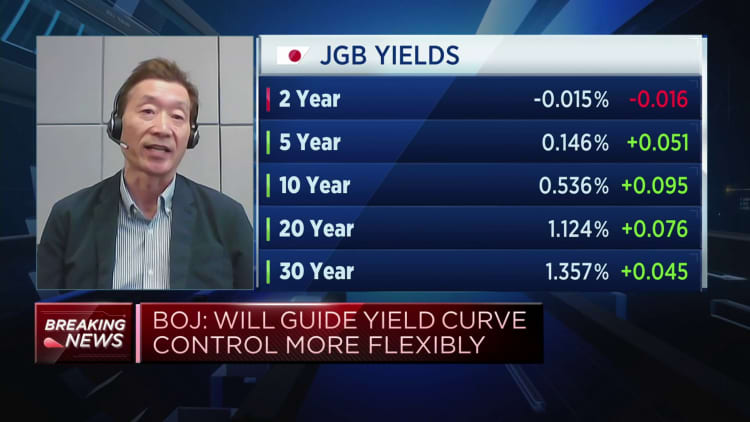Kazuo Ueda, governor of the Bank of Japan (BOJ).
Bloomberg | Bloomberg | Getty Images
The Bank of Japan announced Friday “greater flexibility” in its monetary policy — surprising global financial markets.
The central bank loosened its yield curve control — or YCC — in an unexpected move with wide-ranging ramifications. It sent the yen whipsawing against the dollar, while Japanese stocks and government bond prices slid.
Elsewhere, the Stoxx 600 in Europe opened lower and government bond yields in the region jumped. On Thursday, ahead of the Bank of Japan statement, reports that the central bank was going to discuss its yield curve control policy also contributed to a lower close on the S&P 500 and the Nasdaq, according to some strategists.
“We didn’t expect this kind of tweak this time,” Shigeto Nagai, head of Japan economics at Oxford Economics, told CNBC’s “Capital Connection.”
Why it matters
The Bank of Japan has been dovish for years, but its move to introduce flexibility into its until-now strict yield curve control has left economists wondering whether a more substantial change is on the horizon.
The yield curve control is a long-term policy that sees the central bank target an interest rate, and then buy and sell bonds as necessary to achieve that target. It currently targets a 0% yield on the 10-year government bond with the aim of stimulating the Japanese economy, which has struggled for many years with disinflation.
In its policy statement, the BOJ said it will continue to allow 10-year Japanese government bond yields to fluctuate within the range of 0.5 percentage point either side of its 0% target — but it will offer to purchase 10-year JGBs at 1% through fixed-rate operations. This effectively expands its tolerance by a further 50 basis points.
“While maintaining the tolerance band for the 10-year JGB yield target at +/-0.50ppt, the BoJ will allow more fluctuation in yields beyond the band,” economists from Capital Economics said.
“Their aim is to enhance the sustainability of the current easing framework in a forward-looking manner. Highlighting ‘extremely high uncertainties’ in the inflation outlook, the BoJ argues that strictly capping yields will hamper bond market functioning and increase market volatility when upside risks materialize.”
Next step tightening?
From a market perspective, investors — many of whom were not expecting this move — were left wondering whether this is a mere technical adjustment, or the start of a more…
Click Here to Read the Full Original Article at Top News and Analysis (pro)…


